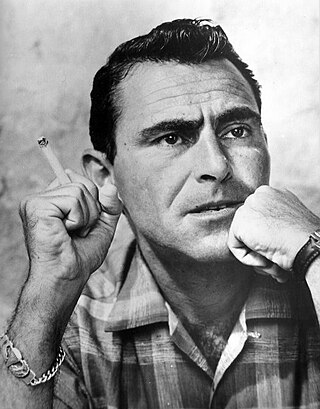
Rodman Edward Serling was an American screenwriter and television producer best known for his live television dramas of the 1950s and his anthology television series The Twilight Zone. Serling was active in politics, both on and off the screen, and helped form television industry standards. He was known as the "angry young man" of Hollywood, clashing with television executives and sponsors over a wide range of issues, including censorship, racism, and war.
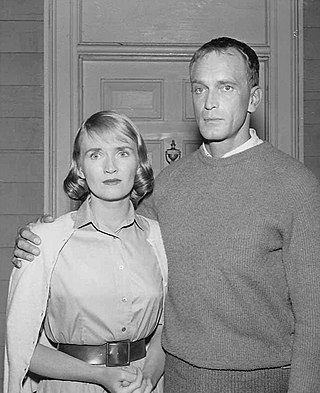
"The Monsters Are Due on Maple Street" is the 22nd episode in the first season of the American television anthology series The Twilight Zone. The episode was written by Rod Serling, the creator-narrator of the series. It originally aired on March 4, 1960, on CBS. In 2009, TIME named it one of the ten best Twilight Zone episodes.
Führer is a German word meaning "leader" or "guide". As a political title, it is strongly associated with Adolf Hitler, the dictator of Nazi Germany from 1933 to 1945. Hitler officially styled himself der Führer und Reichskanzler after the death of President Paul von Hindenburg in 1934 and the subsequent merging of the offices of Reichspräsident and Reichskanzler.
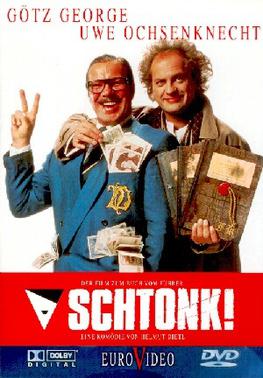
Schtonk! is a 1992 German satirical film which retells the story of the 1983 Hitler Diaries hoax. It was written and directed by Helmut Dietl.

Otto Ernst Remer was a German Wehrmacht officer in World War II who played a major role in stopping the 20 July plot in 1944 against Adolf Hitler. In his later years, he became a politician and far-right activist. He co-founded the Socialist Reich Party in West Germany in the 1950s and is considered an influential figure in postwar neo-fascist politics in Germany.
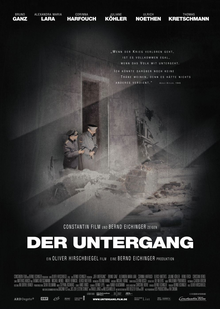
Downfall is a 2004 historical war drama film written and produced by Bernd Eichinger and directed by Oliver Hirschbiegel. It is set during the Battle of Berlin in World War II, when Nazi Germany is on the verge of total defeat, and depicts the final days of Adolf Hitler. The cast includes Alexandra Maria Lara, Corinna Harfouch, Ulrich Matthes, Juliane Köhler, Heino Ferch, Christian Berkel, Alexander Held, Matthias Habich, and Thomas Kretschmann. The film is a German-Austrian-Italian co-production.
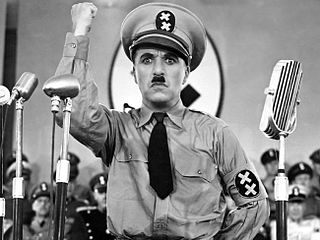
Adolf Hitler, dictator of Germany from 1933 to 1945, has been represented in popular culture ever since he became a well-known politician in Germany. His distinctive image was often parodied by his opponents. Parodies became much more prominent outside Germany during his period in power. Since the end of World War II representations of Hitler, both serious and satirical, have continued to be prominent in popular culture, sometimes generating significant controversy. In many periodicals, books, and movies, Hitler and Nazism fulfill the role of archetypal evil. This treatment is not confined to fiction but is widespread amongst nonfiction writers who have discussed him in this vein. Hitler has retained a fascination from other perspectives; among many comparable examples is an exhibition at the German Historical Museum which was widely attended.

Ernst Franz Sedgwick Hanfstaengl was a German American businessman and close friend of Adolf Hitler. He eventually fell out of favour with Hitler and defected from Nazi Germany to the United States. He later worked for Franklin D. Roosevelt and was once engaged to the author Djuna Barnes.

The flag of Nazi Germany, officially the flag of the German Reich, featured a red background with a black swastika on a white disc. This flag came into use initially as the banner of the Nazi Party (NSDAP) after its foundation. Following the appointment of Adolf Hitler as Chancellor in 1933, this flag was adopted as mandatory for use, while the national one was the black-white-red triband of the German Empire.

Der Sieg des Glaubens is the first Nazi propaganda film directed by Leni Riefenstahl. Her film recounts the Fifth Party Rally of the Nazi Party, which occurred in Nuremberg, Germany, from 30 August to 3 September 1933. The film is of great historic interest because it shows Adolf Hitler and Ernst Röhm on close and intimate terms, before Hitler had Röhm killed during the Night of the Long Knives on 1 July 1934. As he then sought to remove Röhm from German history, Hitler ordered all known copies of the film be destroyed, and it was considered lost until a surviving copy was found in the 1980s in East Germany.

This bibliography of Adolf Hitler is a list of some non-fiction texts in English written about and by him. Thousands of books and other texts have been written about him, so this is far from an all-inclusive list. It has been arranged into groups to make it more manageable.

Erich Kempka was a member of the SS in Nazi Germany who served as Adolf Hitler's primary chauffeur from 1936 to April 1945. He was present in the area of the Reich Chancellery on 30 April 1945, when Hitler shot himself in the Führerbunker. Kempka delivered the petrol to the garden behind the Reich Chancellery, where the remains of Hitler and Eva Braun were burned.
Kurt Lüdecke was an ardent German nationalist and international traveler who joined the Nazi party in the early 1920s and who used his social connections to raise money for the NSDAP. Before attending a rally at which Adolf Hitler was a featured speaker, Lüdecke had assumed that Hitler was simply "one more fanatic" but after hearing Hitler speak at a mass demonstration at the Königsplatz in Munich, he adopted Hitler as his hero: "His appeal to German manhood was like a call to arms, the gospel he preached a sacred truth." The next day, he spoke to Hitler for four hours and offered himself to Hitler and the Nazi cause "without reservation ... I had given him my soul."
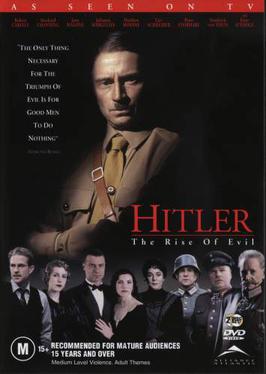
Hitler: The Rise of Evil is a Canadian television miniseries in two parts, directed by Christian Duguay and produced by Alliance Atlantis. It stars Robert Carlyle in the lead role and explores Adolf Hitler's rise and his early consolidation of power during the years after the First World War and focuses on how the embittered, politically fragmented and economically buffeted state of German society following the war made that ascent possible. The film also focuses on Ernst Hanfstaengl's influence on Hitler's rise to power. The miniseries, which premiered simultaneously in May 2003 on CBC in Canada and CBS in the United States, received two Emmy Awards, for Art Direction and Sound Editing, while Peter O'Toole was nominated for Best Supporting Actor.

Men, Heroes and Gay Nazis is a 2005 German documentary film directed, written and produced by Rosa von Praunheim. The film focuses on gay men who align themselves with hardcore authoritarian views, white power skinheads, and Nazis.

Look Who's Back is a bestselling German satirical novel about Adolf Hitler by Timur Vermes, published in 2012 by Eichborn Verlag. The novel was adapted into a German movie of the same name, which was released in 2015.
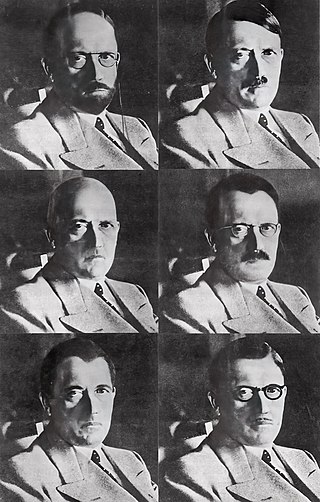
Conspiracy theories about the death of Adolf Hitler, dictator of Germany from 1933 to 1945, contradict the accepted fact that he committed suicide in the Führerbunker on 30 April 1945. Stemming from a campaign of Soviet disinformation, most of these theories hold that Hitler and his wife, Eva Braun, survived and escaped from Berlin, with some asserting that he went to South America. In the post-war years, the United States Federal Bureau of Investigation (FBI) and Central Intelligence Agency (CIA) investigated some of the reports, without lending them credence. The 2009 revelation that a skull in the Soviet archives long (dubiously) claimed to be Hitler's actually belonged to a woman has helped fuel conspiracy theories.

Adolf Hitler, the dictator of Nazi Germany, initiated World War II in Europe with the invasion of Poland in September 1939 and was central to the Holocaust. He was hated by his persecuted enemies and even by some of his own countrymen. Although attempts were made to assassinate him, none were successful. Hitler had numerous bodyguard units over the years which provided security.

Nazi architecture is the architecture promoted by Adolf Hitler and the Nazi regime from 1933 until its fall in 1945, connected with urban planning in Nazi Germany. It is characterized by three forms: a stripped neoclassicism, typified by the designs of Albert Speer; a vernacular style that drew inspiration from traditional rural architecture, especially alpine; and a utilitarian style followed for major infrastructure projects and industrial or military complexes. Nazi ideology took a pluralist attitude to architecture; however, Hitler himself believed that form follows function and wrote against "stupid imitations of the past".

Adolf Hitler's cult of personality was a prominent feature of Nazi Germany (1933–1945), which began in the 1920s during the early days of the Nazi Party. Based on the Führerprinzip ideology, that the leader is always right, promulgated by incessant Nazi propaganda, and reinforced by Adolf Hitler's success in fixing Germany's economic and unemployment problems by remilitarising during the global Great Depression, his bloodless triumphs in foreign policy prior to World War II, and the rapid military defeat of the Second Polish Republic and the Third French Republic in the early part of the war, it eventually became a central aspect of the Nazi control over the German people.

















